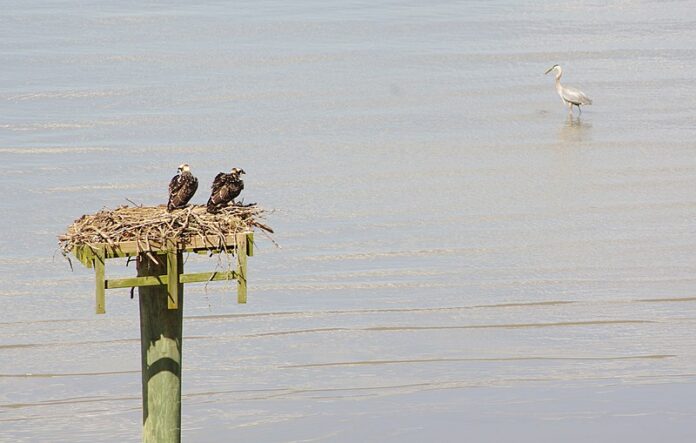BY HARRY WEEKES
I don’t know when or how the beef started. But that there was beef was evident from the first raucous croak.
As human voices have timbre, so do animal voices. I knew before seeing anything that the croak belonged to a Great Blue Heron. It was a big croak. If I wanted to be more specific, I’d say that Great Blue Herons kind of “grunt-croak.” They have this throaty, gravelly, raspy way of speaking that suits their prehistoric and shaggy look.
This wasn’t just a “I’m hanging out at the marsh” kind of croak, though. I knew two things- the bird was flying and something was wrong.
My view corridor afforded a window to the sea, so I looked there for the bird. Sure enough, he or she cruised into view, neck tucked back in its heron-esque way as the bird repeatedly grunt-croaked.
Soon enough, another bird whistle-chirped from somewhere behind. Enter the Osprey. The unhappy member of our little vignette brought up the rear with its version of avian shrieking.
This osprey was audibly upset, beating the air behind and above the heron, emitting sharp, chirpy barks as it gained on the great blue. Then, it dove. Tucking its wings back into its signature dive, the osprey plunged on the heron.
The great blue went from a relatively streamlined and compact silhouette to immediately looking like one of those sticky rubber octopuses you get as a kid that you throw against the window. Instantly, the heron opened up like some kind of ornithological starfish- it expanded its great feathered arms, it jutted out its considerable neck, and its gangly legs splayed like cartoon stilts.
Unphased by this tripling of size, the osprey drove the heron into the ocean where it did something I have never seen a heron do- swim out in open water. The bird chugged along elegantly if not urgently, looking like some weird version of a swan as it hurriedly made toward land.
In the comfort of the shallows, the heron stood as the osprey repeatedly swooped on it. The scene unfolded like this for another minute or so- the osprey yelling its chirps and diving, the heron periodically grunting and bobbing its slender neck as it feinted and fended off this fury from above.
Eventually, the osprey parted with several high-pitched whistles as the heron was joined by another of its kind, who came flapping into the marsh as if to say, “What was that?”
What was that, indeed. Herons and osprey don’t fish in the same places or in the same way. While I have seen eagles and ravens chase osprey for their fish, I can’t imagine that a heron either could or would. At this time of year, osprey babies are way too big to be preyed upon or really even bothered by herons, if herons even do such things. From my vantage point, no food was fought over, no other birds were present, and there was no obvious evidence for the aggrievement. I was left both amused and bemused.
Carl Sagan said “It is of interest to note that while some dolphins are reported to have learned English – up to fifty words used in correct context – no human being has been reported to have learned dolphinese.”
I have no doubt that the osprey and the blue heron knew exactly what was going on and that even across their great evolutionary divide the various croaks and whistles were understood.
The gossipy part of me looked around for any suggestions or answers. Alas, the terns moved on, their little “kips” an additional enigma.
Harry Weekes is the founder and head of school at The Sage School in Hailey. This is his 52nd year in the Wood River Valley, where he lives with Hilary and one of their three baby adults—Simon. The other members of the flock are Georgia and Penelope (Georgia recently fledged from Davidson College in North Carolina and Penelope is at Middlebury College in Vermont).



